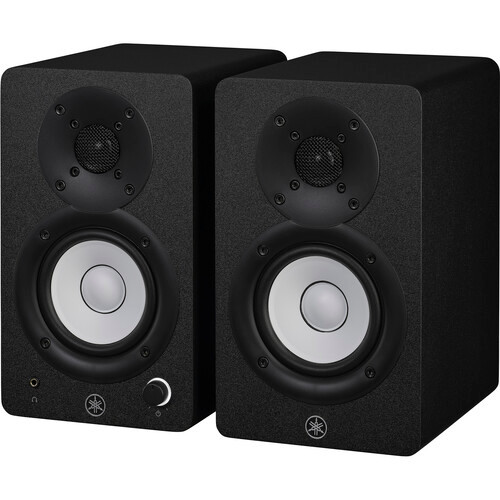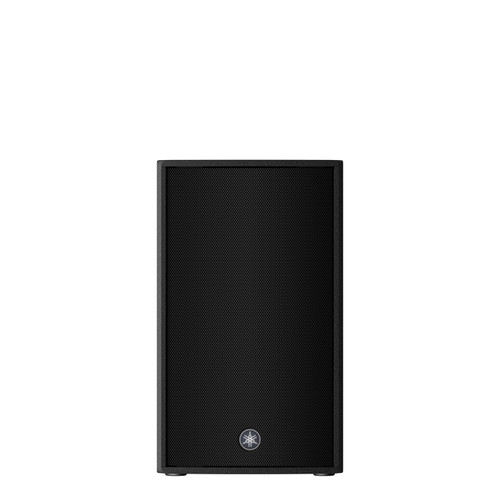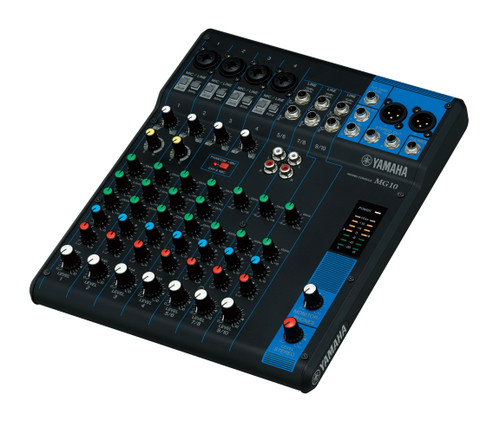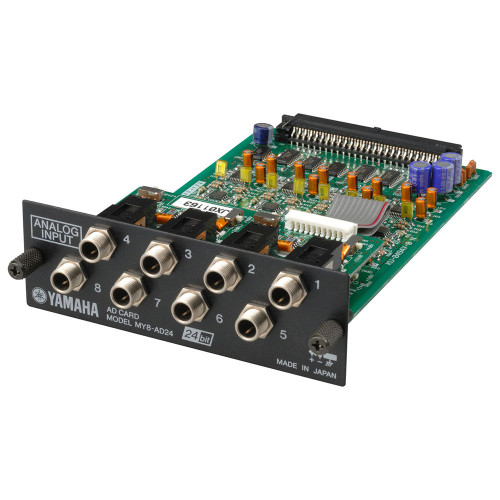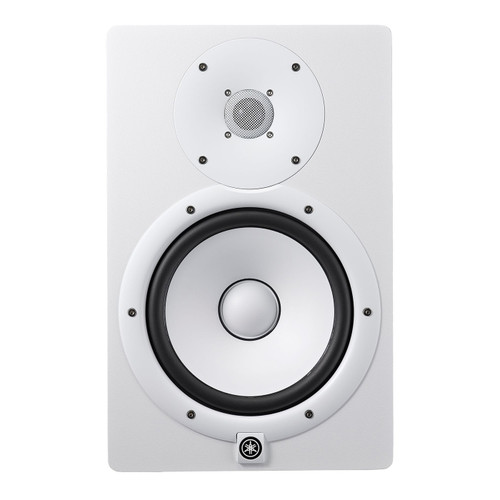TF Series Digital Mixing Console
TF1 Compact Digital Mixing Console
Yamaha has always made it a mission to stay in touch with the needs of sound engineers worldwide. The outcome is evident in the success of the recent CL and QL series digital mixing consoles, and the flagship RIVAGE PM10. The key to success has always been in supporting the user’s creativity. Creativity is most effective when unrestricted, and now Yamaha has created a new digital mixing console that gives the user’s intuition even freer rein. TouchFlow Operation™ introduced in the TF series consoles allows the user to respond to the music and artists on stage with unprecedented speed and freedom, taking live sound reinforcement to a new level of refinement. With the TouchFlow Operation interface optimized for touch panel control, experienced engineers as well as newcomers to the field will find it easier than ever to achieve the ideal mix. Recallable D-PRE™ preamplifiers support sound quality that will satisfy the most discerning professional ears, while advanced live recording features and seamless operation with high-performance I/O racks give these compact digital mixers capabilities that make them outstanding choices for a wide range of applications. Experience the intuitive control and creative freedom that a truly evolved digital console can provide.
| TOUCH OPERATION FOR INTIMATE CONTROL |
|
|
| Refined for the smoothest possible operation via touch-panel control, the TF user interface offers a smooth workflow that can be an advantage in any mixing situation. The display content has been specifically designed for easy, direct accessibility, with a layout that promotes the most natural, efficient mixing. Touch panel operation is as easy as shaping the sound with your fingertips. |
| TOUCH & TURN KNOB OFFERS EXTRA CONTROL PRECISION | |
| When you need extra precision for a fine EQ or other adjustment, the physical Touch & Turn knob is always available right beside the touch panel. There are also four User Defined Knobs below the panel that can be assigned to control compressor threshold, EQ gain, or other parameters you need fast, direct access to while mixing. The knobs always affect the currently selected channel. |
|
| TRADITIONAL OVERVIEW AND SELECTED CHANNEL INTERFACES | |
| Like the CL series consoles, operation is based around Overview and Selected Channel windows. The overview display shows the parameters for eight channels at a time, while the Touch & Turn knob provides direct access to gain, 1-knob EQ™, 1-knob COMP™, gate threshold, effect send level, pan, and other parameters. Touch the highlighted parameter a second time to switch to the Selected Channel display when you need access to detailed parameters for finer control. |
|
| Effective gain, compressor, and EQ setup requires a considerable degree of skill and experience. Even veteran engineers need to spend time on these important basic settings. In addition to their intuitive user interfaces, TF consoles include a number of features that contribute to faster, smoother setup of these essential parameters. | |
| 1-KNOB COMP™ & 1-KNOB EQ™: ONE KNOB TO DIAL IN THE IDEAL SOUND | |
| An experienced engineer can do a lot with a compressor: bring a guitar to life, add punch to bass, tighten up a snare, and make vocals ride clearly on the mix. The 1-knob COMP can do all of this quickly and easily, without the need to juggle multiple parameters to achieve the desired effect. Originally introduced in Yamaha analog mixers, the 1-knob COMP quickly became a popular and valued feature. It has now been further refined in a digital version that adds new setup ease and efficiency to the TF consoles.The same concept has been applied in a new 1-knob EQ feature that provides notably improved speed and smooth operation. 1-knob EQ has been painstakingly fine-tuned by Yamaha R&D staff in cooperation with distinguished sound engineers, to ensure that you can achieve outstanding results with minimum effort in the shortest possible time. A Vocal Mode makes it easier than ever to achieve a clear, well defined vocal sound, while an Intensity Mode offers 1-knob “intensity” control over EQ curves you either select from the presets or create from scratch.But there’s more: the 1-knob COMP and 1-knob EQ are provided on the output channels too, so you can quickly achieve overall output compression or EQ that ideally matches the room and audience size. The output 1-knob EQ has a Loudness Mode in place of the Vocal Mode, effectively increasing the sound pressure level while maintaining optimum sound as you rotate the knob.Both the 1-knob COMP and 1-knob EQ provide quick access to the full compressor and EQ displays, so you can fine tune settings as required. |
|
| GAINFINDER™ SUPPORTS PRECISION GAIN SETUP | |
| Gain is the first adjustment the input signal sees, and the way it is set up influences how subsequent parameters will affect the signal. Yamaha has developed a way to make fast, accurate setup of this important basic parameter easier than ever. The new GainFinder feature facilitates optimum gain setup for individual input signals so that ideal overall operation and signal quality is achieved. The user only has to set channel gain so that the central green indicator in the level meter remains lit for the longest possible time. Of course the level meters also perform their traditional function, so standard gain setup procedure can be followed if preferred. |
|
| The familiar Yamaha scene memory that stores mix settings for instant recall when needed is included as always. There’s also a range of channel presets that have been created in cooperation with leading microphone manufacturers and eminent sound engineers, providing starting points that take you a long way towards achieving great sound.The channel presets cover parameters such as HA gain, EQ, dynamics, and much more, right down to details like channel name and color. Less time needs to be spent on basic setup so that more time is available for refining the mix and communicating with the performers. | |
| QUICKPRO PRESETS™ PROVIDE INSTANT ACCESS TO PRO SOUND SETUPS | |
| Working with microphone manufacturers such as Audio-Technica, Sennheiser and Shure as well as respected engineers, and evaluating a large number of microphones, musical instruments, speaker systems, and in-ear monitors, the Yamaha R&D team focused on creating a range of shortcuts to great sound that would be effective in a wide variety of live-sound situations. Armed with these practical presets even the novice engineer can get very close to the ideal sound, while experienced engineers will appreciate the significant time savings they can provide starting points for further adjustments.The QuickPro Presets can be searched by instrument type and recalled quickly and easily. The presets include HA gain, EQ, Comp and other settings, right down to the channel name and color. The 1-knob EQ and 1-knob COMP can be used with QuickPro Presets, providing a super streamlined way to tweak the sound.The output channel preset library includes parameter sets optimized for Yamaha powered speakers, with several variations to match different environments and room sizes. Presets are provided for in-ear monitors too. All of these can be used as is when time is tight, but they are also great starting points for manual fine tuning. Setups created from the presets or from scratch can be saved as additional presets too. |
|
TF5, TF3, TF1
| Outline | TF5 | TF3 | TF1 | |
|---|---|---|---|---|
| Fader Configuration | 32 + 1 (Master) | 24 + 1 (Master) | 16 + 1 (Master) | |
| Mixing Capacity | Input Channels | 48 (40 mono + 2 stereo + 2 return) | 48 (40 mono + 2 stereo + 2 return) | 40 (32 mono + 2 stereo + 2 return) |
| Aux Buses | 20 (8 mono + 6 stereo) | 20 (8 mono + 6 stereo) | 20 (8 mono + 6 stereo) | |
| Stereo Buses | 1 | 1 | 1 | |
| Sub Buses | 1 | 1 | 1 | |
| Input channel functions | 8 DCA Groups | 8 DCA Groups | 8 DCA Groups | |
| I/O | Inputs | 32 mic/line (XLR/TRS combo) + 2 stereo line (RCA pin) | 24 mic/line (XLR/TRS combo) + 2 stereo line (RCA pin) | 16 mic/line (XLR/TRS combo) + 2 stereo line (RCA pin) |
| Outputs | 16 (XLR) | 16 (XLR) | 16 (XLR) | |
| Expansion slots | 1 | 1 | 1 | |
| On-board processors | DSP | 8 Effects + 10 GEQ | 8 Effects + 10 GEQ | 8 Effects + 10 GEQ |
| USB | 34x34 USB Audio Interface, 2-track recording via USB Storage Device | 34x34 USB Audio Interface, 2-track recording via USB Storage Device | 34x34 USB Audio Interface, 2-track recording via USB Storage Device | |
| General specifications | TF5 | TF3 | TF1 | |
| Sampling frequency rate | Internal | 48 kHz | 48 kHz | 48 kHz |
| Signal delay | Less than 2.6 ms, INPUT to OMNI OUT, Fs=48 kHz | Less than 2.6 ms, INPUT to OMNI OUT, Fs=48 kHz | Less than 2.6 ms, INPUT to OMNI OUT, Fs=48 kHz | |
| Fader | 100 mm motorized, Resolution = 10-bit, +10 dB to –138 dB, –∞ dB all faders | 100 mm motorized, Resolution = 10-bit, +10 dB to –138 dB, –∞ dB all faders | 100 mm motorized, Resolution = 10-bit, +10 dB to –138 dB, –∞ dB all faders | |
| Total harmonic distortion | Less than 0.05% 20 Hz–20 kHz @+4 dBu into 600 , INPUT to OMNI OUT, Input Gain=Min. (Measured with a –18 dB/octave filter@80 kHz) | Less than 0.05% 20 Hz–20 kHz @+4 dBu into 600 , INPUT to OMNI OUT, Input Gain=Min. (Measured with a –18 dB/octave filter@80 kHz) | Less than 0.05% 20 Hz–20 kHz @+4 dBu into 600 , INPUT to OMNI OUT, Input Gain=Min. (Measured with a –18 dB/octave filter@80 kHz) | |
| Frequency response | +0.5, –1.5 dB 20 Hz–20 kHz, refer to +4 dBu output @1kHz, INPUT to OMNI OUT | +0.5, –1.5 dB 20 Hz–20 kHz, refer to +4 dBu output @1kHz, INPUT to OMNI OUT | +0.5, –1.5 dB 20 Hz–20 kHz, refer to +4 dBu output @1kHz, INPUT to OMNI OUT | |
| Dynamic range | 110 dB typ., DA Converter, 107 dB typ., INPUT to OMNI OUT, Input Gain=Min. | 110 dB typ., DA Converter, 107 dB typ., INPUT to OMNI OUT, Input Gain=Min. | 110 dB typ., DA Converter, 107 dB typ., INPUT to OMNI OUT, Input Gain=Min. | |
| Hum & noise level | Equivalent input noise | –128 dBu typ., Input Gain=Max. (Measured with an A-Weight filter) | –128 dBu typ., Input Gain=Max. (Measured with an A-Weight filter) | –128 dBu typ., Input Gain=Max. (Measured with an A-Weight filter) |
| Residual output noise | –85 dBu, ST master off (Measured with an A-Weight filter) | –85 dBu, ST master off (Measured with an A-Weight filter) | –85 dBu, ST master off (Measured with an A-Weight filter) | |
| Crosstalk | –100 dB (Measured with a –30 dB/octave filter@22 kHz), adjacent INPUT/OMNI OUT channels, Input Gain=Min. | –100 dB (Measured with a –30 dB/octave filter@22 kHz), adjacent INPUT/OMNI OUT channels, Input Gain=Min. | –100 dB (Measured with a –30 dB/octave filter@22 kHz), adjacent INPUT/OMNI OUT channels, Input Gain=Min. | |
| Power requirements | 100–240 V 50/60 Hz | 100–240 V 50/60 Hz | 100–240 V 50/60 Hz | |
| Power consumption | 120 W | 110 W | 100 W | |
| Dimensions | W | 866 mm (34.1in) | 716 mm (28.2in) | 510 mm (20.1in) |
| H | 225 mm (8.9in) | 225 mm (8.9in) | 225 mm (8.9in) | |
| D | 599 mm (23.6in) | 599 mm (23.6in) | 599 mm (23.6in) | |
| Net weight | 20.0 kg (44.1lb) | 17.0 kg (37.5lb) | 13.5 kg (29.8lb) | |
| Accessories | Quick Guide, Power Cord, CUBASE AI download information | Quick Guide, Power Cord, CUBASE AI download information | Quick Guide, Power Cord, CUBASE AI download information | |
| Options | Expansion Card, Foot Switch (FC5) | Expansion Card, Foot Switch (FC5) | Rack-mount Kit RK5014, Expansion Card, Foot Switch (FC5) | |
| Others | Operating temperature range: 0–40 °C, Storage temperature range: -20–60 °C | Operating temperature range: 0–40 °C, Storage temperature range: -20–60 °C | Operating temperature range: 0–40 °C, Storage temperature range: -20–60 °C | |
ANALOG INPUT CHARACTERISTICS
| Input Terminals | GAIN | Load Impedance | For Use With Nominal | Input Level | Connector | balanced / Unbalanced | ||
|---|---|---|---|---|---|---|---|---|
| Sensitivity*1 | Nominal | Max. before clip | ||||||
| INPUT1-32 (TF5) INPUT1-24 (TF3) INPUT1-16 (TF1) |
+66dB | 7.5K Ω | 50-600 Mics or 600 Lines |
-82dBu (61.6V) | -62dBu (0.616mV) | -42dBu (6.16mV) | Combo Jack (XLR-3-31 type *2 or TRS phone *3) |
Balanced |
| -6dB | -10dBu (245mV) | +10dBu (2.45V) | +30dBu (24.5V) | |||||
| ST IN 1,2 | - | 10k | 600 Lines | -30dBV (31.6V) | -10dBV (316mV) | +10dBV (3.16V) | RCA Pin Jack | Unbalanced |
*1. Sensitivity is the lowest level that will produce an output of +4dBu (1.23V) or the nominal output level when the unit is set to maximum gain. (All faders and level controls are at maximum position.)
*2. 1: GND, 2: HOT, 3: COLD
*3. Tip: HOT, Ring: COLD, Sleeve: GND
*4 In these specifications, 0dBu = 0.775Vrms.
*5.+48V DC (phantom power) can be supplied to INPUT XLR type connectors via each individual software controlled switch.
ANALOG OUTPUT CHARACTERISTICS
| Output Terminals | Source Impedance | For Use With Nominal | GAIN SW | Output Level | Connector | balanced / Unbalanced | |
|---|---|---|---|---|---|---|---|
| Nominal | Max. before clip | ||||||
| OMNI OUT 1-16 | 75Ω | 600 Lines | “+24dBu” position (default) |
+4dBu (1.23 V) | +24dBu (12.3 V) | XLR-3-32 type *1 | Balanced |
| PHONES *5 | 100Ω | 40 Phones | - | 3mW | 75mW | Stereo Phone Jack (TRS) *2 | Unbalanced |
*1.1: GND,2: HOT, 3: COLD
*2 Tip: LEFT, Ring: RIGHT, Sleeve: GND
*3 In these specifications, 0dBu = 0.775Vrms.
*4 All output DA converters are 24bit, 128times oversampling.
*5 The position of the level control is lowered by 16dB from the maximum.
DIGITAL INPUT/OUTPUT SPECIFICATIONS






















